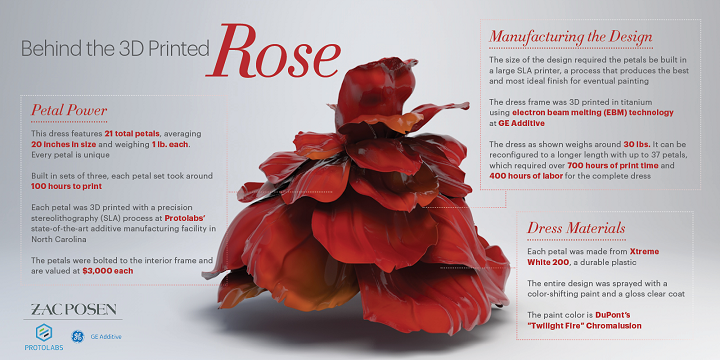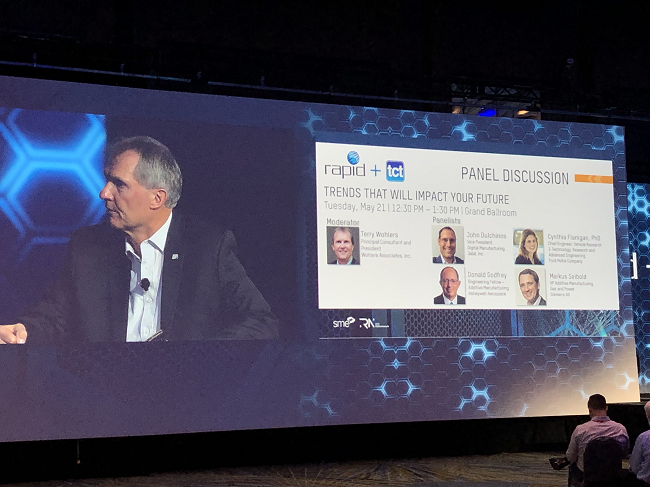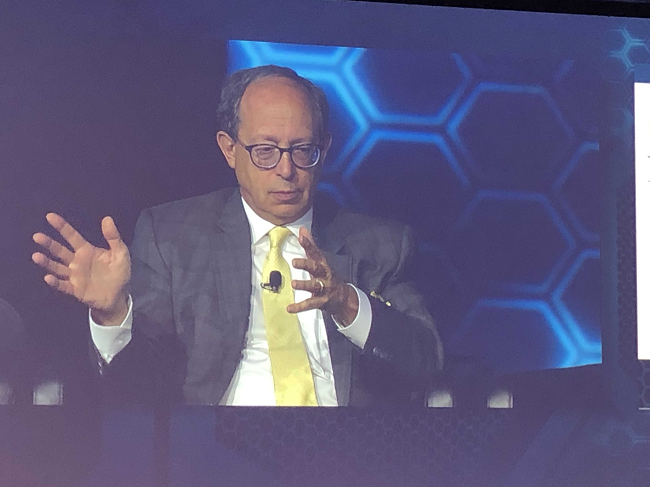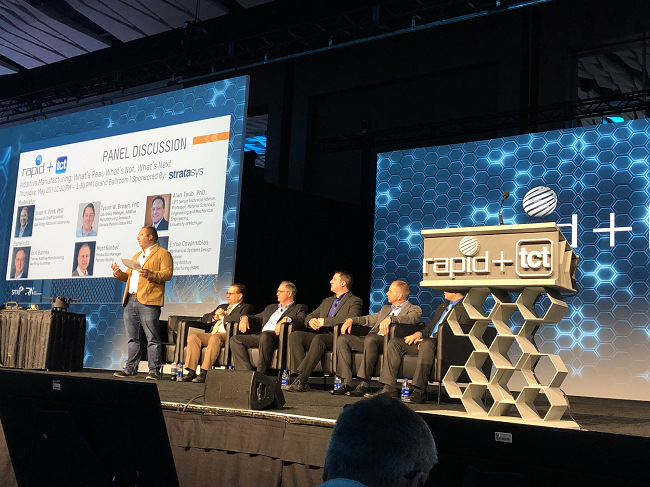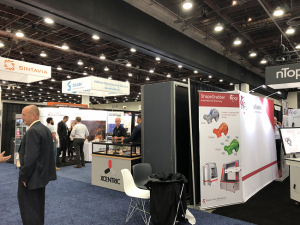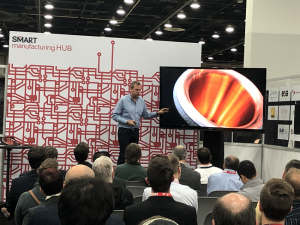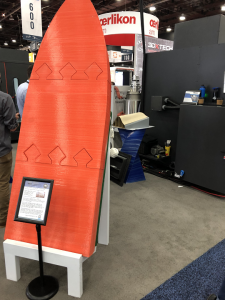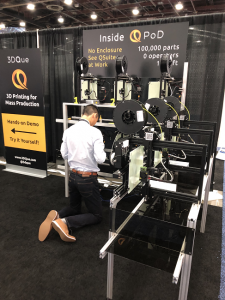 I didn’t just visit companies at their booths during the recent RAPID + TCT – I made time in my schedule to attend a few interesting sessions as well, including one by design engineer Sarah Watson from GE Additive‘s design consulting team AddWorks and applications engineer Eric Utley from Protolabs – moderated by Sarah Goehrke – about their recent collaboration with fashion designer Zac Posen for this year’s Met Gala. Once Posen contacted AddWorks, they reached out to Protolabs, due to its vast experience with polymers.
I didn’t just visit companies at their booths during the recent RAPID + TCT – I made time in my schedule to attend a few interesting sessions as well, including one by design engineer Sarah Watson from GE Additive‘s design consulting team AddWorks and applications engineer Eric Utley from Protolabs – moderated by Sarah Goehrke – about their recent collaboration with fashion designer Zac Posen for this year’s Met Gala. Once Posen contacted AddWorks, they reached out to Protolabs, due to its vast experience with polymers.
Together, Posen and his AM partners combined 3D printing technology with fashion design techniques, conceptual thinking, and CAD to come up with several unique pieces for the annual Metropolitan Museum of Art’s Costume Institute fundraiser event. It certainly sounded like an interesting collaboration in terms of communication – Watson said this was the first time a customer had ever sent her a ‘mood board,’ and that Posen and his design team were more ‘cerebral’ than engineers would be.
“Every project develops its own vernacular,” she explained. “It was just more extreme in this case.”
Just as they would with more traditional manufacturing applications like heat exchangers, the team started with a big concept idea when it came to designing the stunning Rose Dress, which was worn at the Met Gala by supermodel Jourdan Dunn. Metal 3D printing definitely came in handy when it came to making the dress more lightweight so Dunn could actually wear the gown, and the titanium cage underneath the petals was designed in such a way that the majority of the weight was on her hips.
[Image: Protolabs]
Utley said that the timeline was definitely the “#1 difficulty in this project,” and explained that they started 3D printing the petals before the final dress design was even complete, stating that choices like this were about risk mitigation. All told, the 3D printing, post-processing, and finishing of the Rose Dress took over 1,100 hours. Watson admitted that the team initially tried to steer Posen away from designs that would require so much custom finishing, but he “stuck to his guns,” and the resulting pieces are simply gorgeous because of it.
I also attended a thought leadership panel discussion, moderated by Wohlers Associates‘ president and principal consultant Terry Wohlers, called “Trends that Will Impact Your Future.” The panelists were Jabil’s VP of Digital Manufacturing John Dulchinos; Ford Motor Company’s Chief Engineer of Vehicle Research & Technology, Research and Advanced Engineering Cynthia Flanigan, PhD; Honeywell Aerospace’s AM Engineering Fellow Donald Godfrey; and Markus Seibold, the VP of Additive Manufacturing, Gas and Power for Siemens AG.
“A lot of people, when you go around this conference, are going to talk design for additive manufacturing,” said Godfrey. “You can do that, and we [Honeywell] are, but you can only do that for new products. The FAA is not going to let you change the shape of a component that’s already been certified. If you do that, then you have to re-certify the engine, and we’re not going to do that. We’re just not going to re-certify the engine for an airplane. So we are printing designs, and we call it ‘make for additive manufacturing.’ So if it’s a casting thing, you make that exact same shape…otherwise, you’re re-certifying. So for the next five years, we’re not looking for vendors to design for us. We’re looking for vendors who can print for us. So, what holds them back?”
The answer, he said, is a lack of good material property data.
“For each alloy, you’re talking a few million dollars,” Godfrey explained. “So if you look around the world and you see these shops, they don’t have the financial resources to do that. They’re already leveraged in buying a machine, so all of that is done internally. So what we’re trying to do now is find the companies, even our competitors…we’ll give you 400 tensile specimens of 718 if you give us 400 specimens of – pick the alloy.”
Flanigan noted that Ford was was taking note of the digitalization trend, which can help companies “control where the workflow goes.”
“We’re set up in conventional manufacturing at multiple sites, and we have processes in place to manage that, but especially as we move to additive manufacturing and we really think about what that future looks like, that’s really key for us – looking at having a physical and a digital twin in the process, and making sure that each site has the same capabilities in terms of process control and environment…and we look at technologies that enable that,” she explained.
Dulchinos brought up the fact that two of the larger industries using additive technology – aerospace and medical – do so because they will pay high prices for parts in order to achieve valuable performance gains:
“I think as we kind of look more broadly across the industry, certainly going from aerospace and medical and performance automotive into more mainstream industries like automotive, we’ve got to drive a more broad-based adoption.”
Godfrey came back to this point later from a different angle.
“I have companies come to us all the time, some of them have machines, some of them have no machines,” he said, noting that he was referring to large industrial 3D printers. “If we give them X amount of guaranteed orders, they’ll go buy machines and set up a factory for us. It doesn’t work that way…there’s no guarantee we have that you know what you’re doing, or we’ll know what you’re doing. The problem, I think, a lot of [little] companies have – and those little companies are great engineering organizations – but at the end of the day, cash flow is everything. And a lot of these companies are leveraged to the hilt, and as we bring them on, we have to be cautious of that because there’s a chance they’ll go bankrupt.
“They’re not going to make that commitment until there’s some sort of financial reward. There are very few companies out there that can throw 50, 60 million dollars around like it’s nothing.”
Donald Godfrey, Honeywell Aerospace
Seibold chimed in here as well:
“If I compare additive with established supply chains – machining, in our case, every turbine blade needs root machining. Conventional machining has been out there for decades. But still, our strategic procurement organization, they go to the same two or three root machining vendors year in, year out. We’re trading volumes amongst them so that we can drive prices. Because it’s a very specialized operation and you, as a specialized OEM, you want the company to be specialized in your material, in your requirements, because it’s surface roughness, it’s, whatever it is for you, and these suppliers know that. And sometimes one eventually even has a little bit of the impression with additive today, just because it’s becoming mainstream technology, everybody who is in the supply chain also would want to add additive to their capabilities. And at some point, you want specialists out there…not anyone who just can buy a machine for financial reasons.
“Today everybody can get a CNC machine…but still, large companies go to their established suppliers. And so I guess it is very important to be dedicated to either an industry, dedicated to either a class or application, whatever it is so you become a specialist. Because if you’re just trying to be another active vendor, I don’t think that there is a long-lasting space in a big OEM supply chain.”
Later, Flanigan mentioned what Ford was doing in terms of assessing new material systems or processes that might allow the company to offer more personalization:
“We’ve been working with several startups in different technologies, additive being one of those, and we see that as one way to engage larger corporations and to have some of those partnerships before getting to more of the downstream into the production system aspects.”
 Another presentation I attended during RAPID was a #3DTalk panel about process and quality control. The industry-specific series of events led by women in 3D printing is the brainchild of Cyant and Women in 3D Printing, and this particular panel was moderated by Jennifer Fielding, Section Chief for Composite Performance and Applications at the Air Force Research Laboratory; she was also a panelist for the #3DTalk panel at last year’s RAPID.
Another presentation I attended during RAPID was a #3DTalk panel about process and quality control. The industry-specific series of events led by women in 3D printing is the brainchild of Cyant and Women in 3D Printing, and this particular panel was moderated by Jennifer Fielding, Section Chief for Composite Performance and Applications at the Air Force Research Laboratory; she was also a panelist for the #3DTalk panel at last year’s RAPID.
The topic of the #3DTalk was how to integrate additive manufacturing into heavily regulated industries, such as aerospace. To discuss this important theme, three panelists were chosen who have plenty of experience in these fields – biomedical engineer Amy Alexander, BME, MS, who works in the Anatomic Modeling Lab at the Mayo Clinic and was a keynote speaker at last year’s RAPID; Ellen Lee, PhD, a Technical Leader in Additive Manufacturing and Research & Advanced Engineering for Ford Motor Company; and the president and CTO of Rapid Prototype and Manufacturing LLC (rp+m), Tracy Albers.
The panelists discussed their first experiences with 3D printing: Alexander said that this occurred for her in the 2000s, while Lee and Albers were both introduced to the materials side around nine years ago. Albers mentioned that the CEO of her company at the time was the one who told her that they needed to look into the technology, and that she herself had asked why, stating that they needed to figure out when 3D printing would actually add value to the company. Fielding asked if it had been the appropriate time, and Albers said that while she didn’t believe it was necessary for the company at the time, she found her CEO’s comments to be “thought-provoking.”
Then they moved on to current 3D printing experiences. Alexander said she agreed with Albers about meaningful use of the technology, stating that “it comes down to what surgeons find most helpful” at Mayo, which hosts a whole fleet of 3D printers for a variety of specific uses, like molds, surgical cutting guides, and color models. While she said that 3D printing was “not always the answer” to every problem, it’s definitely a useful tool to have.
Lee said that Ford was looking at SLA 3D printing and moving to more functional prototyping, with the end goal being series production. Albers explained that, as a contract manufacturer, rp+m wants to have “all the machines that customers needs us to have,” but that the company is still conservative when it comes to investing in new equipment. Unfortunately, I had to leave at this point to go conduct an interview, so I didn’t get to listen to the rest of the discussion.
 On the last day of RAPID, I attended a panel presentation called “What’s Real, What’s Not, What’s Next,” which was sponsored by Stratasys and moderated by Brian Post, PhD, a Research Staff Scientist from Oak Ridge National Laboratory (ORNL). The panelists were Eric Barnes, an AM Fellow with Northrop Grumman; Tyson W. Brown PhD, Lab Group Manager for AM Research with General Motors’ Global R&D team; Matt Gimbel, the Production Manager for Penske Racing; Alan Taub, PhD, LIFT Senior Technical Advisor and Professor of Material Sciences & Engineering and Mechanical Engineering with the University of Michigan; and Ernie Covarrubias, a Mechanical Systems Design Engineer with Boeing Additive Manufacturing (BAM).
On the last day of RAPID, I attended a panel presentation called “What’s Real, What’s Not, What’s Next,” which was sponsored by Stratasys and moderated by Brian Post, PhD, a Research Staff Scientist from Oak Ridge National Laboratory (ORNL). The panelists were Eric Barnes, an AM Fellow with Northrop Grumman; Tyson W. Brown PhD, Lab Group Manager for AM Research with General Motors’ Global R&D team; Matt Gimbel, the Production Manager for Penske Racing; Alan Taub, PhD, LIFT Senior Technical Advisor and Professor of Material Sciences & Engineering and Mechanical Engineering with the University of Michigan; and Ernie Covarrubias, a Mechanical Systems Design Engineer with Boeing Additive Manufacturing (BAM).
After the panelists all introduced themselves and talked a little about the various ways their companies use 3D printing, Post asked a great question: are your industry’s needs being met with additive manufacturing?
Dr. Brown started off by explained that GM is “very broad,” and makes 10 billion cars.
“If you want to know if we can get a 3D printed part in every one of those cars, the answer is no,” he stated.
But he continued that the company had been using the technology for years, so the answer to the question changes to “yes, in that sense.”
“Really it depends on how you define the problem,” Dr. Brown said.
Dr. Taub said that the technology really needs quality and repeatability to be an economically viable choice for production purposes.
“The key is, can we model it for validation and certification?” he explained.
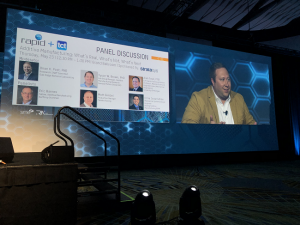 Barnes was pretty positive on this, stating that Northrop Grumman makes parts in low volumes with “relatively easy shapes” that are definitely “economically viable” for 3D printing. Gimbel agreed with Barnes “in terms of volume,” but stated that the certification process is a little different for race cars.
Barnes was pretty positive on this, stating that Northrop Grumman makes parts in low volumes with “relatively easy shapes” that are definitely “economically viable” for 3D printing. Gimbel agreed with Barnes “in terms of volume,” but stated that the certification process is a little different for race cars.
Post then asked the group to name one thing they’d like to improve about 3D printing for their individual industries. Covarrubias said he’d like to make post-processing easier and less expensive, because so many things have to be tested and all companies have different ways of performing post-processing and finishing. Dr. Taub said he’d like to improve long-term performance, and to get through high-volume validation, as the industry requires reproducibility.
Barnes agreed with Dr. Taub that repeatability is necessary, because they “need to know how a part will perform.”
“Predictability is very important for aircraft,” Barnes stated.
At the end, Post opened the discussion up to the audience for questions, and one gentleman near the front of the room asked what they were learning about the integration of technologies like 3D printing and artificial intelligence, and where a company that wants to figure out advanced manufacturing should start.
“A lot of us [bigger players] are getting involved in building the entire ecosystem around additive,” Dr. Brown said. “We don’t have the supply chains built in…when there’s not an easy switch to turn on a whole industry to make additive solutions for everybody, it’s something that we see as we need to be there and developing the whole economy around it, and making everybody successful, not just hoarding the ability, because in the end that hurts ourselves because we’re not able to work as a part of an ecosystem.”
Gimbel came at the question from the angle of a small company just starting out.
“If I was starting a new company, you’re looking at different technologies. One thing I’ve learned is get as hands-on as possible – talk to people who are actually using the equipment, talk to the manufacturers, and just try to understand what they’re doing and where they’re going,” he said.
Stay tuned for more news from my time at RAPID, and take a look at some other pictures I took below:
- EOS: 3D printing liquid rocket engines
- Titan Robotics
- Impossible Objects
- 3DQue
Discuss this story and other 3D printing topics at 3DPrintBoard.com or share your thoughts below.
[Images: Sarah Saunders unless otherwise noted]Subscribe to Our Email Newsletter
Stay up-to-date on all the latest news from the 3D printing industry and receive information and offers from third party vendors.
You May Also Like
Profiling a Construction 3D Printing Pioneer: US Army Corps of Engineers’ Megan Kreiger
The world of construction 3D printing is still so new that the true experts can probably be counted on two hands. Among them is Megan Kreiger, Portfolio Manager of Additive...
US Army Corps of Engineers Taps Lincoln Electric & Eaton for Largest 3D Printed US Civil Works Part
The Soo Locks sit on the US-Canadian border, enabling maritime travel between Lake Superior and Lake Huron, from which ships can reach the rest of the Great Lakes. Crafts carrying...
Construction 3D Printing CEO Reflects on Being Female in Construction
Natalie Wadley, CEO of ChangeMaker3D, could hear the words of her daughter sitting next to her resounding in her head. “Mum, MUM, you’ve won!” Wadley had just won the prestigious...
1Print to Commercialize 3D Printed Coastal Resilience Solutions
1Print, a company that specializes in deploying additive construction (AC) for infrastructure projects, has entered an agreement with the University of Miami (UM) to accelerate commercialization of the SEAHIVE shoreline...


